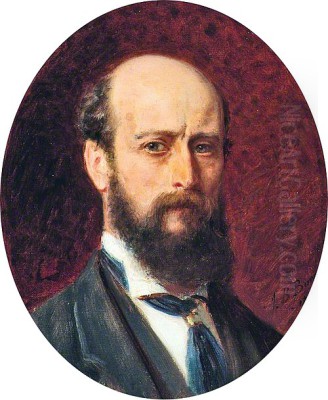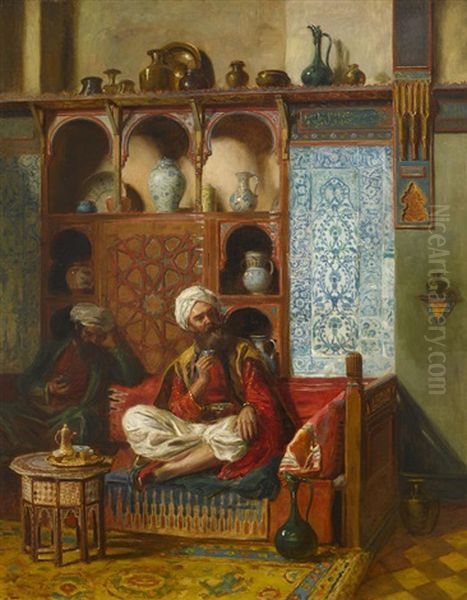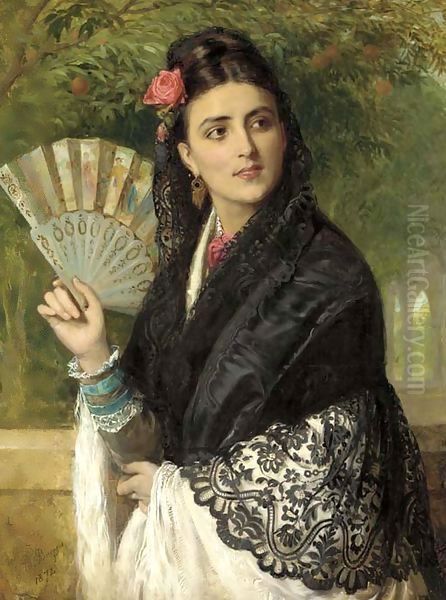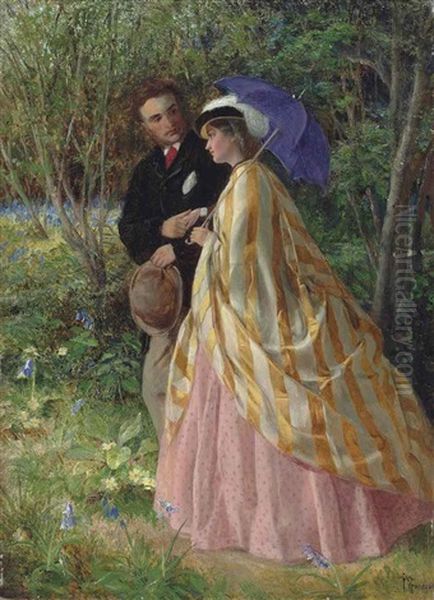
John Bagnold Burgess stands as a significant figure within the vibrant tapestry of 19th-century British art. A prominent member of the Royal Academy, he carved a distinct niche for himself through his evocative genre scenes, particularly those inspired by his travels in Spain and North Africa. Born in Chelsea, London, on October 21, 1829 (though some sources state 1830), and passing away in London on November 12, 1897, Burgess navigated the Victorian art world with considerable success, leaving behind a legacy of technically accomplished and popularly appealing works. His paintings, often rich in narrative detail and local colour, captured the imagination of his contemporaries and continue to offer valuable insights into the artistic tastes and cultural interests of the era.
Early Life and Artistic Formation
John Bagnold Burgess was fortunate to be born into an artistic milieu. His father, Henry William Burgess, was a landscape painter of some note, providing young John with an early immersion in the world of art. Further artistic lineage came through his mother's family, the Rosses, connecting him to Sir William Charles Ross, a celebrated miniature painter who served Queen Victoria. This familial background undoubtedly fostered his innate talent and inclination towards the visual arts from a young age.
Recognizing his potential, Burgess received formal training to hone his skills. He initially studied at Leigh's Academy in Soho, London, a well-regarded private art school run by James Mathews Leigh. This institution was a crucial stepping stone for many aspiring artists of the time, known for its rigorous drawing instruction, often serving as a preparatory school for the prestigious Royal Academy Schools. Fellow students who passed through Leigh's around this period included future luminaries like John Everett Millais and Dante Gabriel Rossetti, highlighting the calibre of instruction and peer environment.

Following his time at Leigh's, Burgess gained admission to the Royal Academy Schools around 1849 or 1850. This was the premier art institution in Britain, offering unparalleled training and access to the heart of the London art world. During his studentship, Burgess distinguished himself, notably winning the first-class silver medal for drawing from life. This early accolade signalled his technical proficiency and dedication, laying a solid foundation for his future career as a professional painter.
Rise Through the Royal Academy
The Royal Academy of Arts was the undisputed centre of the British art establishment in the 19th century. Acceptance into its schools and, more importantly, having work selected for its annual Summer Exhibition, was crucial for an artist's reputation and commercial success. Burgess began exhibiting at the Royal Academy consistently from 1850 onwards, marking the start of a long and fruitful relationship with the institution.
His early works displayed competence but did not immediately focus on the Spanish subjects that would later define his career. He explored historical scenes and contemporary British life, gradually building his reputation among critics and patrons. The consistent quality of his submissions and his growing profile led to his election as an Associate of the Royal Academy (ARA) on June 19, 1877. This was a significant honour, recognizing him as one of the country's leading artists.
Elevation to full Academician status (RA) followed just over a decade later, on May 5, 1888. Becoming a Royal Academician was the pinnacle of artistic achievement in Britain at the time. It conferred considerable prestige, entitled the artist to exhibit a certain number of works at the Summer Exhibition without prior submission to the selection committee, and involved them in the governance and teaching activities of the Academy. Burgess remained an active member, exhibiting regularly until the year of his death. His journey through the ranks of the RA exemplifies a successful career path within the Victorian art system.
Artistic Style: Victorian Genre and Romantic Sensibilities
John Bagnold Burgess worked firmly within the tradition of Victorian genre painting. This style, immensely popular throughout Queen Victoria's reign, focused on scenes of everyday life, often imbued with narrative elements, anecdotal detail, and sometimes sentimental or moralizing undertones. Artists like William Powell Frith, famous for panoramic scenes like Derby Day, epitomized one aspect of this trend. Burgess, however, brought his own distinct flavour to the genre.

His style combined meticulous attention to detail, characteristic of Victorian painting, with a certain Romantic sensibility. This was particularly evident in his choice of subjects – the picturesque landscapes, vibrant costumes, and expressive faces encountered during his travels abroad. He possessed a strong command of drawing and composition, arranging his figures and settings to create engaging and legible narratives. His use of colour was often rich and warm, enhancing the atmosphere of his scenes, especially those set under the Spanish sun.
While contemporary movements like the Pre-Raphaelite Brotherhood, led by figures such as Millais, Rossetti, and William Holman Hunt, focused on intense detail, symbolism, and often literary or medieval themes, Burgess's work generally remained more grounded in observable reality and anecdotal storytelling. He was less concerned with radical stylistic innovation and more focused on capturing character, emotion, and the specifics of a particular cultural setting. His technical approach was polished and highly finished, aligning with the expectations of the Royal Academy and its patrons.
The Allure of Spain and Moorish Themes
The defining characteristic of John Bagnold Burgess's mature work is his fascination with Spain and, to some extent, North Africa (often referred to generally as 'Moorish' themes in the Victorian era). From the late 1850s onwards, he made numerous trips to the Iberian Peninsula, often accompanied by his close friend and fellow artist, Edwin Long. Long himself became renowned for his large-scale historical and archaeological paintings, often set in ancient Egypt or Babylon, but he shared Burgess's interest in Spanish subjects early in his career.
Spain held a particular allure for British artists and travellers in the 19th century. Following the Napoleonic Wars, the country became more accessible. Romantic writers like Washington Irving had popularized its history and landscapes, particularly the legacy of Moorish Spain in Andalusia. For artists like Burgess, Spain offered a wealth of 'picturesque' material: dramatic landscapes, historic architecture, vibrant street life, distinct regional costumes, and expressive people whose way of life seemed a world away from industrializing Britain. It provided an escape into a seemingly more traditional, passionate, and visually rich culture.

Burgess was not the first British artist to explore Spanish themes. Sir David Wilkie had travelled there, as had the Scottish painter John Phillip, who became so associated with the country he was nicknamed 'Phillip of Spain'. David Roberts was famous for his topographical views of Spanish cities and monuments. Burgess built upon this tradition, focusing less on grand historical narratives or precise architectural records and more on intimate scenes of daily life, social interactions, and character studies. His depictions of Spanish peasants, priests, letter writers, musicians, and families resonated with Victorian audiences, who appreciated the blend of exoticism and relatable human incident.
His travels likely included extended stays in cities like Seville and Granada, centres of Andalusian culture. He would have sketched prolifically, gathering material – studies of faces, costumes, architectural details, market scenes – to be worked up into finished oil paintings back in his London studio. These works were consistently well-received at the Royal Academy exhibitions, cementing his reputation as a leading painter of Spanish life.
Representative Works
Throughout his career, Burgess produced a substantial body of work, with several paintings standing out as particularly representative of his style and thematic interests.
Licensing the Beggars, Spain (1865): This painting, now in the collection of Royal Holloway, University of London, was one of his early major successes focusing on Spanish life. It depicts a scene outside a government office where beggars are receiving official licenses allowing them to solicit alms. The work showcases Burgess's skill in composing multi-figure scenes, capturing a range of character types and social interactions within a specific cultural context. It demonstrates his eye for anecdotal detail and the social fabric of Spanish society.
Good News and Bad News (1876): Exhibited at the Royal Academy, this painting exemplifies Burgess's narrative approach. It portrays two young Portuguese women (though often discussed alongside his Spanish works) reacting differently to letters received, presumably at a post office counter. One beams with joy, while the other appears crestfallen. The contrast allows Burgess to explore different emotional states and invites the viewer to speculate on the contents of the letters. The detailed rendering of costume and setting adds to the scene's realism and charm.
Arabs Drinking Tea (1875): This work reflects the 'Moorish' or North African dimension of his interests, although the distinction between Spanish Moorish influence and contemporary North African subjects was sometimes blurred by Victorian artists. The painting likely depicts a scene observed during travels, showcasing figures in traditional attire engaged in a social ritual. Such works appealed to the Victorian taste for the exotic and provided Burgess an opportunity to display his skill in rendering rich textiles and varied physiognomies. Its estimated value in modern auctions indicates the continued appreciation for his work.

A Spanish Beauty: Titles like this suggest a focus on idealized female figures, often depicted in traditional Spanish attire like mantillas. These works combined portrait-like qualities with genre elements, celebrating a romanticized vision of Spanish femininity. They were highly popular and contributed significantly to his commercial success. Walter Chamberlain Urwick, another artist of the period, also painted similar romanticized female figures, though perhaps with a different stylistic emphasis.
Friendly Advice: This title suggests another narrative scene, likely involving an intimate conversation or moment of guidance between figures. Such subjects allowed Burgess to explore subtle human emotions and relationships, a hallmark of successful genre painting.
Lovers conversing in a bluebell wood: While known for Spanish themes, this title indicates Burgess also painted scenes closer to home, engaging with the British landscape and romantic pastoral traditions. It highlights his versatility beyond his primary specialization, depicting a quintessential English springtime scene imbued with romantic sentiment.
These examples illustrate the range within Burgess's oeuvre, from detailed multi-figure narratives and ethnographic studies to more intimate character pieces and occasional departures into different settings. Common threads include strong storytelling, careful observation of costume and custom, an emphasis on expressive faces and gestures, and a high level of technical finish.
Contemporaries and Artistic Circle
John Bagnold Burgess operated within a thriving and competitive London art world. His closest artistic relationship seems to have been with Edwin Long, his travel companion in Spain. Their shared interest in Spanish and later, for Long, broader historical and 'Orientalist' themes, suggests mutual influence and support.
As a prominent RA member, Burgess exhibited alongside the leading artists of his day. The Royal Academy Summer Exhibitions were vast affairs, featuring works by established figures and emerging talents across various genres. He would have known and exhibited alongside painters like:
William Powell Frith: Master of the panoramic modern-life scene.
Lawrence Alma-Tadema: Renowned for his meticulously researched scenes of classical antiquity.
Frederic Leighton: President of the Royal Academy, known for his classical and biblical subjects executed with academic perfection.
Luke Fildes and Frank Holl: Painters who sometimes tackled grittier subjects of social realism, offering a contrast to Burgess's often more picturesque view of life.
Hubert von Herkomer: A versatile artist working in portraiture, social realism, and historical subjects.
John Phillip: The aforementioned predecessor in popularizing Spanish themes in Britain.
Jean-Charles Cazin: A French landscape and figure painter who exhibited internationally, including at the RA.
William Merritt Chase: A leading American Impressionist who also exhibited abroad.
Burgess's work also fits within the broader European context of 'Orientalism' and the artistic interest in depicting cultures outside of Northern Europe. While perhaps less overtly dramatic or ethnographic than some French Orientalists like Jean-Léon Gérôme, or American counterparts like Frederick Arthur Bridgman, Burgess's Spanish and Moorish scenes catered to a similar public fascination with the exotic 'Other'.
His family connections, particularly to Sir William Charles Ross, also placed him within established artistic circles from an early age. While he doesn't seem to have been part of a specific 'clique' or formal group beyond the RA itself, his consistent success and membership in the Academy ensured he was a well-regarded figure within the mainstream art scene. His works found their way into important collections, displayed alongside British masters like J.M.W. Turner and John Constable in regional galleries like the Bury Art Museum, indicating his accepted place within the canon of British art during his lifetime.
Later Life, Personality, and Legacy
John Bagnold Burgess continued to paint and exhibit actively throughout the 1880s and 1890s. His Spanish subjects remained popular, and he maintained his position within the Royal Academy. However, details about his personality and private life are relatively scarce compared to some of his more flamboyant contemporaries.
One poignant insight comes from the period after his death. Burgess never married and had no children. His assistant, John Starling Chapple, expressed a sense of deep personal loss, writing about feeling his "truly lonely position" after Burgess's passing. This suggests that while Burgess achieved considerable professional success and recognition, his personal life may have been marked by a degree of solitude. This contrasts with the often lively and sociable depictions in his paintings.
He passed away in his London home at 60 Finchley Road on November 12, 1897, at the age of 67 or 68. His death was noted in the art press, acknowledging the loss of a respected Royal Academician.
Burgess's legacy is primarily that of a highly skilled and successful Victorian genre painter who specialized in Spanish themes. He catered effectively to the tastes of his time, providing audiences with engaging narratives, picturesque settings, and glimpses into a culture perceived as both romantic and exotic. His technical abilities were considerable, particularly his draughtsmanship and his handling of colour and texture.
Like much Victorian academic art, Burgess's reputation waned significantly with the rise of Modernism in the early 20th century. The detailed realism and narrative focus of his work fell out of favour with critics and artists championing abstraction and formal innovation. However, in recent decades, there has been a renewed scholarly and public interest in Victorian painting, leading to a reappraisal of artists like Burgess.
His works are now recognized for their artistic merit within their historical context and as valuable documents of Victorian cultural interests, particularly the fascination with Spain. They offer insights into 19th-century travel, ethnographic representation, and the conventions of genre painting. His paintings are held in various public collections, including the Royal Academy of Arts in London, the Detroit Institute of Arts, the Bury Art Museum, and Royal Holloway, University of London, ensuring his contribution to British art history is preserved and accessible.
Conclusion
John Bagnold Burgess RA was a quintessential Victorian artist in many ways. He navigated the established structures of the art world, achieving success through talent, hard work, and a keen understanding of public taste. His training at Leigh's Academy and the Royal Academy Schools provided him with a formidable technical grounding, which he applied to subjects that captured the Victorian imagination.
His specialization in Spanish and Moorish genre scenes became his trademark, transporting viewers to sunnier climes filled with picturesque characters and anecdotal incidents. Works like Licensing the Beggars, Spain, Good News and Bad News, and A Spanish Beauty exemplify his ability to blend detailed observation with engaging storytelling and romantic sensibility. He stood alongside prominent contemporaries like Edwin Long, William Powell Frith, and John Phillip, contributing significantly to the richness and diversity of 19th-century British art.
While his personal life may have held elements of quiet solitude, his professional life was one of consistent achievement and recognition within the highest echelons of the London art world. Today, John Bagnold Burgess is remembered as a master technician and a key chronicler of Spanish life through Victorian eyes, his paintings offering a window onto a specific moment in art history and the enduring appeal of cultural encounter.